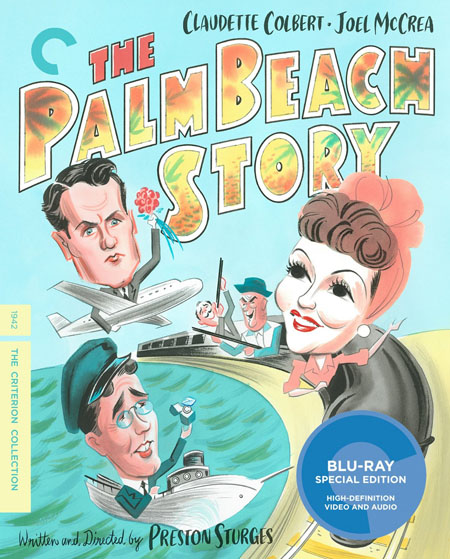
WACKY WEDDED BLISS
By Raymond Benson
Preston
Sturges was a rare breed in Hollywood in the early 1940s—he was a
writer/director auteur who penned
original comedies and directed them himself. Perhaps Chaplin—and Keaton, to a
degree—were the only other filmmakers up to that point who did the same,
picture after picture. Sturges began as a screenwriter authoring some of
Hollywood’s better comedies of the late ‘30s; finally, he told Paramount he
would sell them his script for The Great
McGinty only if they allowed him to direct it. The studio bosses relented
when Sturges took a cut in salary to do both jobs. McGinty was a hit and went on to win a screenplay Oscar for
Sturges. Then, during the war years, Sturges enjoyed his remarkable run before
succumbing, in the later years of the decade, to the inevitable “falling out of
fashion†that so often occurs in Tinsel Town.
Sturges’
comedy is sophisticated, intelligent, and witty; but it’s also wacky, off the
wall, and spitfire fast. He specialized in screwball comedy—i.e., absurdly zany
love stories between two likable but eccentric characters—and The Palm Beach Story, released in 1942,
is a prime example. Following his masterpiece (but, at the time, misunderstood
and not well received financially) Sullivan’s
Travels, Palm Beach stars Joel
McCrea (“Tomâ€) and Claudette Colbert (“Gerriâ€â€”Tom and Gerri, get it?) as an
unhappily married couple who split up and ultimately get back together. Classic
screwball comedy structure. What makes the film different from other screwball
comedies is what happens in-between. And at the beginning.
Ah,
the beginning. Over the main title credits, we see a series of strange clips
that appear to be taken from later in the picture—but they’re not. In fact,
they’re never really explained at all, which does cause some confusion with the
audience. This opening has been debated by film scholars ever since the movie’s
release. It’s actually exposition, but cut down to brief snippets of visuals,
edited to the tune of a rollicking William
Tell Overture. We see a maid frightened by an imposing figure—she faints. A
concerned priest is at the altar, looking at his watch. We see Colbert, tied up
and gagged in a closet. And then we see Colbert in a wedding dress, rushing to
get ready? Is she the same Colbert as before? After that we
discover McCrea in wedding garb rushing to get in a car—obviously late for the
ceremony. But in the car he changed into another
set of wedding clothes. The bridal Colbert runs by the maid, who screams
and faints again. The tied and gagged Colbert breaks out of her binds and kicks
her way out of the closet. The recovering maid sees her, screams, and faints. Then the parties rush to the chapel—where
McCrea and Colbert (which one?) get married. The caption reads: “And they lived
happily ever after... or did they?â€

We
don’t really find out what was going on in the credits until the end of the
movie in a somewhat contrived but typically Sturges-style explanation of what’s
been going on in the picture. It’s not a spoiler to reveal that Colbert plays
twin sisters, but McCrea also plays
twin brothers. The two sisters are in love with one of the McCrea twins (not “Tomâ€),
and he is about to marry the one who is not named Gerri. However, Gerri has
tied up her sister and taken her place at the altar—but somehow “Tom†has taken
his brother’s place at the chapel—and Tom and Gerri—the wrong couple—get
married. At least that’s how I interpret
it.
After
five years of marriage, Tom and Gerri are at each other’s throats (but they
really do love each other, they just don’t realize it yet). Gerri leaves for
Palm Beach and Tom follows her. Gerri begins a relationship with billionaire
Rudy Vallee, and Tom is snared by Vallee’s maneating sister, Mary Astor, and
then things really get complicated.
Throw
in Sturges’ standard stock company of character extras—William Demarest, Sig
Arno, Robert Dudley, Franklin Pangborn, Arthur Hoyt, Chester Conklin, Jimmy
Conlin, Robert Warwick, and several others (all faces you will recognize but
won’t know their names) and you’ve got one crazy oddball of a movie. And it’s
marvelous.
Criterion’s
4K digital restoration looks gorgeous, as always (how does Criterion manage to get the best-looking presentations of
black and white classic films on Blu-ray?). There are two new video interviews
with (a) writer and film historian James Harvey about Sturges and his works,
and (b) comedian and actor Bill Hader, also about Sturges and the picture. A
WW2 propaganda film, written by Sturges for the State Department, Safeguarding Military Information, is
included (and features Sturges regular Eddie Bracken). A 1943 radio adaptation
by Screen Guild Theater is also included, plus the informative essay by critic
Stephanie Zacharek in the booklet.
It’s
too bad that Preston Sturges’ flame burnt out by the end of the forties—he was
a talent that was often miles ahead—and above—his peers. The Palm Beach Story, while perhaps not his best work, is certainly
indicative of the man’s genius.
CLICK HERE TO ORDER FROM AMAZON